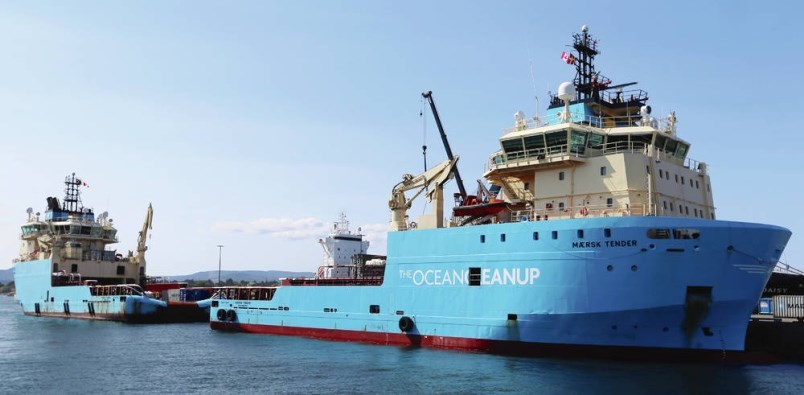An expedition largely supported by Maersk, the world's largest container shipping company, to clean up tonnes of plastics swirling inside the Great Pacific Garbage Patch has launched with two ships leaving Victoria’s Ogden Point this week for the first of two six-week voyages.
The three-month-long, multimillion-dollar venture will test a new system to trap ocean plastics.
Based on previous trials with earlier versions of collection systems, the new design is 800 metres long with a three-metre-deep skirt underwater to catch plastic below the surface.
Dubbed Jenny, the plastic-extraction system was created to concentrate floating plastics and hold them for loading onto vessels. Vessels will slowly tow it through the water. If it works, the plan is to build bigger versions for larger-scale cleanups.
The venture is a project of the Ocean Cleanup organization — a non-profit based in Rotterdam in the Netherlands — which has a goal of cleaning up 90 per cent of the plastics in the world’s oceans by 2040.
Joost Dubois, director of communications for the Ocean Cleanup, likens the experimental system to an artificial coastline.
It will be towed into place by the Maersk Tender and Trader boats, each 73 metres long, which have been moored at Ogden Point. Maersk is a logistics partner with Ocean Cleanup.
Dubois said from the Netherlands that the boats could leave as early as Wednesday.
The blue and white vessels with a total crew of 45 will go out for six weeks and then return to Victoria to pick up another crew and return to the garbage patch.
The plastic waste is located in five main “gyres” or swirling currents, including the area known as the Great Pacific Garbage Patch in the North Pacific, from the west coast of North America to Japan. The patch is about the size of France.
The Ocean Cleanup estimates there are more than 1.8 trillion pieces of plastic in the patch, weighing an estimated 80,000 tonnes.
Arjen Tjallema, the Ocean Cleanup's technology manager, said in a video on social media that the first voyage will put the plastic-extraction system through a testing program that includes keeping a close eye on the marine environment to watch for any interactions with marine life.
A test run of plastics-extraction procedures is planned, including getting the plastics on board the ships. Engineers will be on hand to see how the system performs in different conditions, such as speed, wind, waves, and currents.
After initial testing is completed, the configuration they believe will perform the best will be deployed, Tjallema said.
Boyan Slat, founder of the Ocean Cleanup, said it’s expected to take about three months post-deployment to determine how it performed.
If it works as hoped, “We intend to keep the system out as long as possible until it gets replaced. And in that time, we would expect to clean an area the size of a football field every 15 seconds.”
Nets pulling plastics out of the water have a fine mesh, Dubois said. Similar to a fishing net, they open at the bottom, allowing contents to spill out.
Staff on board the Maersk ships will examine the plastic to determine its origins.
The second voyage is expected to pull in the largest amount of plastics.
The plastics will be put into containers and sent to Europe to be recycled, Dubois said.
The costs of the trial are not being released, but he said it’s more than $5 million.
If the system performs as hoped, another scaled-up project will be carried out in 2022 or 2023. Positive results would see more systems deployed and sent to various garbage sites in the oceans.



